Habitat loss from urbanization and agricultural intensification is reducing populations of pollinators, including native bees and monarch butterflies (Danaus plexippus), all over the world (Goulson et al. 2015). Recent evidence indicates that features of urban landscapes such as warmer temperatures and less viable habitat reduce the number and/or diversity of pollinators that live in these spaces (Biesmeijer et al. 2006; Kremen et al. 2007; Winfree et al. 2011; Blackmore et al. 2014; Hamblin et al. 2017). Similarly, monarch butterfly population declines have been estimated at over 80% since 2005 (Brower et al. 2018).
Due to their large footprint amidst urban areas, golf courses present an excellent opportunity to mitigate the negative effects of urbanization on pollinators. Golf courses are often islands of vegetation surrounded by roads and buildings, harboring wildlife, reducing temperatures, sequestering carbon, and providing outdoor recreational space for urban residents (Lonsdorf et al. 2021). Despite public perception, research has shown that golf courses can support more species and a greater abundance of wildlife than their surrounding habitats or other urban green spaces (Colding and Folke 2009; Mata et al. 2017). However, this is dependent on the diversity, identity, and acreage of plants on a given course.
Although golf courses provide multiple benefits, 40–70% of US golf course acreage is not used for the game of golf, yet is primarily composed of mowed and maintained turfgrasses (Lyman et al. 2007). Moreover, the average Florida golf course is over 100 acres, 90% of which is irrigated (Hodges and Stevens 2010). With more golf courses than any state in the United States, Florida's golf industry is poised to be a national leader for environmental stewardship in the golf industry (Hodges and Stevens 2010; SRI 2015). Golf course superintendents are interested in reducing management inputs and providing more ecological value by repurposing out-of-play areas into more environmentally and economically functional spaces.
This publication is intended to provide guidelines for Florida golf course superintendents to aid in their efforts to conserve important wildlife, while reducing maintenance inputs and associated costs.
Conservation Habitat
Conservation habitat can take many forms, particularly in tropical or subtropical climates where plant and animal diversity is high. To function properly, wildlife conservation habitat must provide valuable resources in the form of food and/or refuge to attract and support a reproductive population. These requirements differ depending on the wildlife or ecological niche of interest and can be tailored to individual groups. For example, pollinating insects rely on flowering plants for pollen and nectar, which sustain pollinator nutrient requirements and reproduction, but these insects also require suitable nesting habitat, which comes in various forms. Some insects, like monarch butterflies, require a specific host as a caterpillar but can use various hosts as an adult (see https://edis.ifas.ufl.edu/in780). Ground-dwelling beneficial insects or spiders often rely on dense, structurally complex vegetation instead of flowering plants. Therefore, when creating conservation spaces, it is important to evaluate their intended purpose and to design them accordingly.
Plant Selection
An important aspect of creating wildflower habitats is selecting the appropriate wildflower species based on site conditions (e.g., sun exposure, soil moisture); geographic region (e.g., tropical, subtropical, temperate); and anticipated level of maintenance. Several drought-tolerant wildflower species will do poorly if over-irrigated, and many species will do poorly if fertilized. The performance of other species will vary greatly depending on the sunlight and soil moisture conditions. Therefore, careful consideration and selection of wildflower species is critical.
In addition to site conditions, wildflowers can also be selected based on the wildlife they support. For example, monarch butterfly caterpillars rely on milkweed species (Asclepias spp.) for larval development and reproduction. Other plants are known to attract specific predatory or parasitic insects. Non-native shrubby false buttonweed (Spermacoce verticillata), for instance, is highly attractive to the mole cricket parasitoid Larra bicolor, which controls invasive mole crickets (Frank et al. 1995; Abraham et al. 2010; Portman et al. 2010). Similarly, partridge pea (Chamaecrista fasciculata), a common native wildflower, and white Pentas lanceolata, a common ornamental, are also highly attractive to Larra bicolor (Abraham et al. 2010; Portman et al. 2010).
Aesthetic quality is also a major aspect of golf course design and plant selection. Therefore, considering color, texture, seasonality, and other components contributing to the aesthetic appeal of a habitat throughout the year is very important. Identifying and mixing wildflower species that flower at various times of the year will maximize the aesthetic quality and the environmental benefits, creating a landscape element that stays colorful and beautiful nearly year-round while providing constant floral resources and habitat for beneficial arthropods.
Table 1 (see page 9) provides an example of different wildflower mixtures that prolong the time of year during which at least one species is in bloom. For landscape design guidance, visit https://edis.ifas.ufl.edu/topic_landscape_design.
For additional guidance on wildflower species selection, visit:
- Common native wildflowers of north Florida (https://edis.ifas.ufl.edu/ep061).
- Performance and seasonality of several native wildflower species in north Florida (https://edis.ifas.ufl.edu/ep341).
Site Preparation and Planting
Among the most important steps for creating wildflower habitats is proper site selection, preparation, and seed planting. Irrigation is important immediately after planting, and fertilization is not recommended. Wildflower species selection (see above) and ensuring the planting site matches the requirements (e.g., sunlight, soil moisture) of the wildflower species selected is critical to successful establishment.
Site preparation: Site preparation should typically occur between July and October. To control existing vegetation, make 2–3 applications of a nonselective herbicide (e.g., glyphosate). Make one application every two weeks. After plants have died, carefully remove plant residue from the soil surface to expose bare soil without disturbing the soil. It is important to minimize soil disturbance to reduce weed pressure during wildflower establishment. Dead plant material can be raked off. In cases with severe thatch or matted dead plant tissue, a sod cutter can be used to remove the top ~2 inches with limited soil disturbance. Bare soil is needed before seeding.
Wildflower seeding: Seeding should typically be done between September and January, depending on location within Florida. For specific timing recommendations, see https://edis.ifas.ufl.edu/in1180. Pure live seed (PLS) are the seeds of a plant species that will germinate from a seed package, accounting for the impurities and weed seed present in the package. Percent PLS can be calculated by multiplying the percent pure seed and germination rate, then multiplying by 100. Each of these values should be listed on the seed package label. Next, multiply the percent PLS by the seed package weight to determine the amount (lbs) of PLS in the package. Most seed packages provide the number of seeds per pound.
The target pure live seed (PLS) density at planting should be 80–120 seeds per square foot, or 80,000–120,000 PLS per 1,000 ft.2 (~4 million PLS per acre). Seeds are sold by weight, so it is important to calculate the number of PLS per unit weight to achieve 80–120 PLS per square foot. Check the germination rate listed on the label of each species. Material with over 75% germination rate is suggested. It is also important to check for seed dormancy and seed treatments to reach a high germination rate. For example, most milkweed species seeds require a period of cold to break seed dormancy. Without breaking this dormancy, seeds will have a low germination rate. After selecting and preparing the seeds, they can be broadcast with a drop spreader, rotary spreader, hand-held rotary spreader, or simply by hand. Go over the seeded plot lightly with a steel rake, light roller, or harrow rake to ensure seed-to-soil contact after broadcasting the seed.
Plot irrigation: Irrigate ¼ inch per day for 2–4 weeks after seeding, depending on weather conditions and precipitation.
Weed management: Weeds are typically the most challenging aspect of creating and maintaining wildflower habitats. It is important to accept that some weeds will always be present in the habitats. Healthy, vigorous wildflowers will outcompete, or resist being outcompeted, by most weeds. Manually pull weeds once every 2 weeks during the first 3 months of wildflower seed germination. Recently germinated weeds and wildflowers look similar, so be sure to only remove germinating weeds. (Creating a photo guide of the young wildflowers is helpful.) After wildflowers are approximately one foot tall, manually pull weeds once every 3 weeks. Weeding frequency can decrease as the plot ages.
End-of-year maintenance: For annuals that die back during the growing season, cut seed heads from the plant, leave them on the ground for germination, and remove bulk dead plant material. During the weeks from mid-December to early February, manually remove remaining large plants killed by seasonal cold. You may also choose to boost variability by culling a portion of the more aggressive wildflower species to provide space for less aggressive species. Mow to ~6". Remove the bulk of debris using a rake or mowing bag. Mowing and raking allows plants to naturally re-seed the plot and opens up the canopy to promote airflow and facilitate seed germination for the following year.
- UF/IFAS guide to planting wildflower enhancements in Florida (https://edis.ifas.ufl.edu/in1180).

Credit: Tyler Jones, UF/IFAS
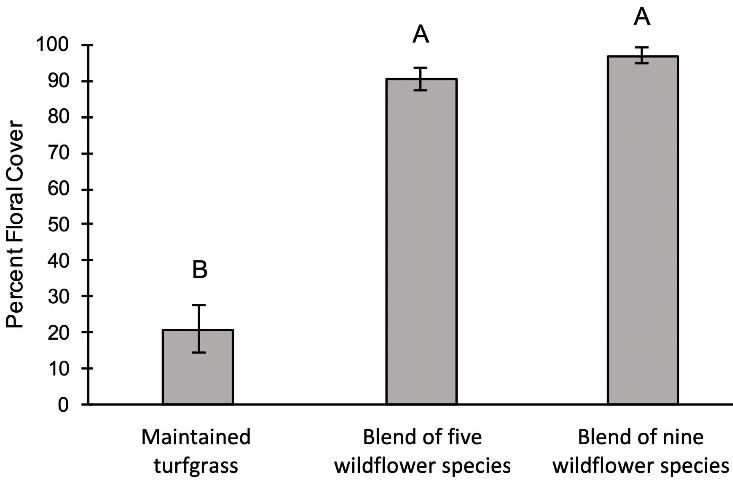
Estimated Costs of Wildflower Habitats
Maintaining out-of-play areas on golf courses is time intensive and can require significant monetary inputs in the form of pesticides, fertilizers, and mowing time to maintain aesthetic quality and minimize pests. A major benefit of converting these areas to flowering habitats is a reduction in irrigation, mowing, pesticide use, and fertilization. Most wildflower habitats do not require fertilization, are irrigated only during establishment or periods of prolonged drought, need be mowed only once per year, and perform well with relatively few chemical inputs (usually just applications of small amounts of herbicide as needed to control aggressive weeds). However, wildflower habitats are not maintenance free and do require time and effort to create and maintain as attractive and beneficial spaces. To inform the costs associated with creating wildflower habitats as seen in Figure 1, a summary of estimated costs associated with wildflower habitat creation and maintenance was created (Table 2). This cost estimate is based on a 5,000 ft.2 plot and represents the initial cost of site preparation and wildflower establishment. Costs in subsequent years should be less.
Weed management costs can vary depending on the site history. A site with a history of many annual weeds will have a seed bank that may sprout readily along with the wildflowers. Early removal of these weeds prevents them from blooming and adding to that seed bank. As the seed bank is depleted, weed control needs will decrease. Fortunately, many wildflower species are unaffected by grass-specific herbicides like fluazifop (trade name: Fusilade), and so this herbicide can be used to control many grasses emerging among the wildflowers. Check the product label, consult UF/IFAS resources, or ask your local Extension agent or wildflower seed salesperson about fluazifop sensitivity of the wildflowers you select.
Benefits of Wildflower Habitats
Conserving Pollinators
Creating wildflower habitats boosts general pollinator abundance and more diverse wildflower mixtures provide greater benefits for native bees (Figure 3a). UF/IFAS research found that, on average, native bees were over four times more abundant in wildflower plots composed of nine species compared to turfgrass areas, and three times more abundant compared to a mix of five wildflower species (Figure 3b) (Dale et al. 2020). This illustrates that golf course out-of-play areas can play a valuable role in native bee conservation.
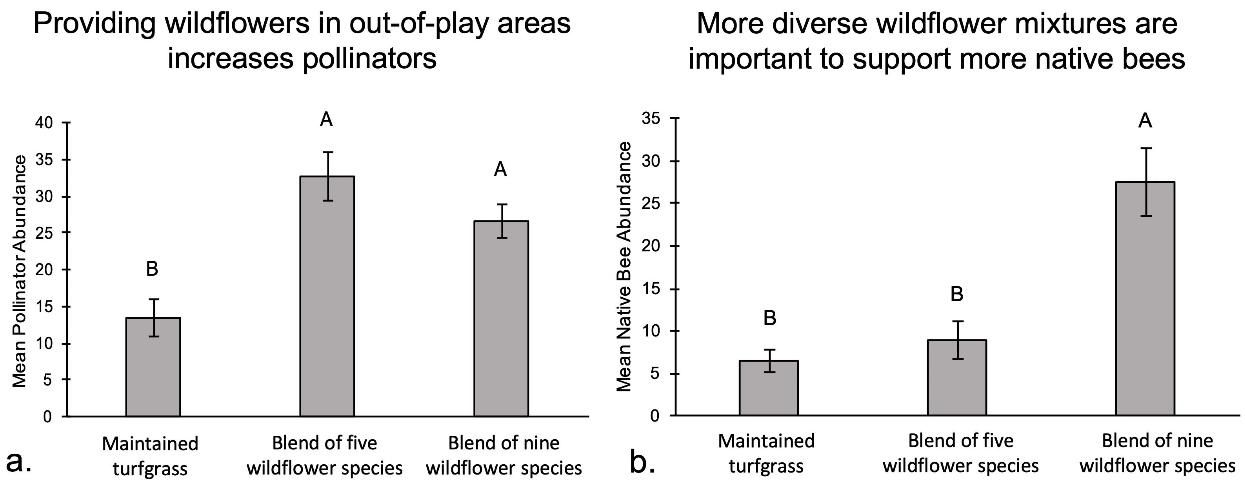
Conserving Butterflies
In addition to native bees, butterfly conservation is increasingly important because populations are declining with habitat loss and global change (Pelton et al. 2019). Wildflower habitats can be highly attractive to adult butterflies through proper plant selection and habitat design. Butterfly larvae (caterpillars) require host plants as food to complete their lifecycle and need nectar resources as adults. Wildflower habitats can be manipulated to fit the needs of specific butterfly species and maximize butterfly use. For example, monarch butterflies prefer milkweed host plants that are tall and have large leaves (Baker and Potter 2018), and they lay more eggs on milkweed host plants in wildflower species mixtures than in single milkweed species monocultures (Nestle et al. 2020). In addition, milkweed in a wildflower mixture should be planted along the edges of habitats (Baker and Potter 2019) or in descending height with tallest plants facing north to assist monarchs with finding and laying eggs on host plants. Habitats can also be designed to conserve multiple butterfly species by incorporating more than one butterfly species host plant and selecting wildflower species (e.g., Hibiscus coccineus, Helianthus angustifolius, Liatris spicata) that are attractive to adult butterflies. In addition, many generalist butterflies may use wildflower species as both a nectar resource and a host plant for offspring. Overall, it is recommended to include both host plants and nectar resources to increase butterfly abundance and richness in wildflower habitats.
Increasing Biological Control of Turfgrass Pests
Many insects attracted to wildflower habitats feed on pollen and nectar in addition to other insects. The invasive tawny and southern mole crickets are attacked by a parasitoid wasp, Larra bicolor, that feeds on nectar of the flowers Spermacoce verticillata and Chamaecrista fasciculata. This wasp can reduce mole cricket abundance in pastures up to 200 m. from the flowers (Portman et al. 2010). Incorporating these species into wildflower mixtures can promote the abundance of this wasp, which may reduce mole cricket abundance and damage in golf course turfgrass.
Similarly, many other predatory and parasitic insects become more abundant when provided with diverse wildflower mixtures (Figure 4a). This increase in predator and beneficial parasite abundance translates to up to 50% increased biological control of fall armyworm caterpillars in nearby fairways at least 60 feet away (Figure 4b). Just as mixtures of nine wildflower species got the best response from native bees when compared to turfgrasses or mixtures of five wildflower species, the nine-species wildflower mixtures also have the greatest benefit for flying predatory and parasitic insects (Dale et al. 2020).
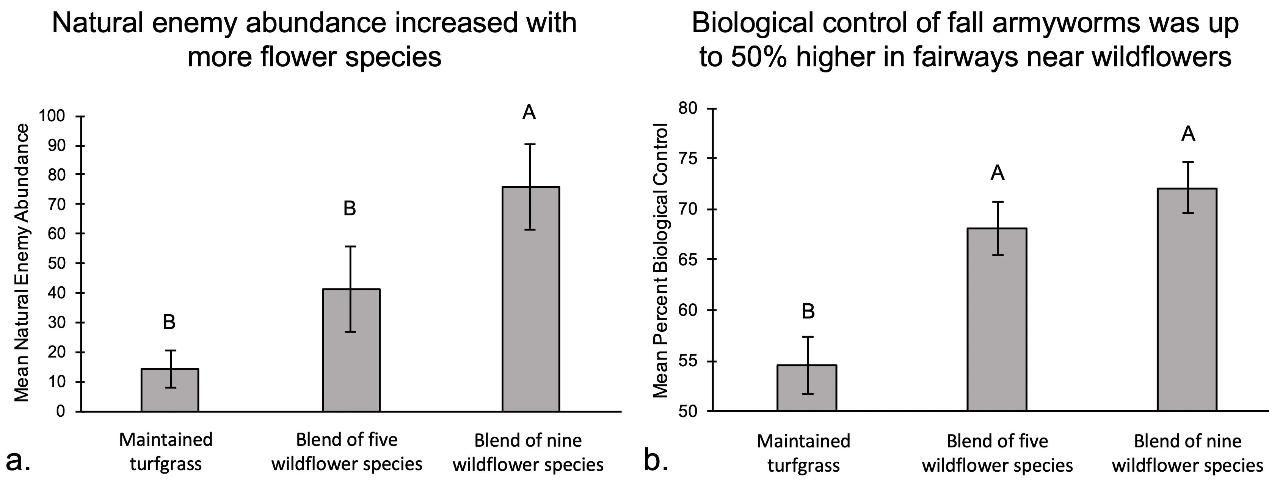
In addition to flowering plants, nesting habitat is a critical resource for native bees and solitary wasps. A common and effective approach to providing nesting habitat is setting up bee "hotels" or nesting boxes (Figure 5). These birdhouse-like structures contain hollow reeds and wooden blocks with holes for solitary bees and wasps to colonize and reproduce. On north central Florida golf courses, the most abundant insect to colonize solitary bee hotels was the red and black mason wasp (Pachodynerus erynnis) (Figure 5), an important predator of caterpillars, including fall armyworm (Spodoptera frugiperda) and tropical sod webworm (Herpetogramma phaeopteralis) (Dale et al. 2020). This wasp captures caterpillars and stuffs them into nesting cavities where they are sealed in and fed upon by wasp larvae. For more information on this insect, see: http://entnemdept.ufl.edu/creatures/MISC/WASPS/Pachodynerus_erynnis.html.
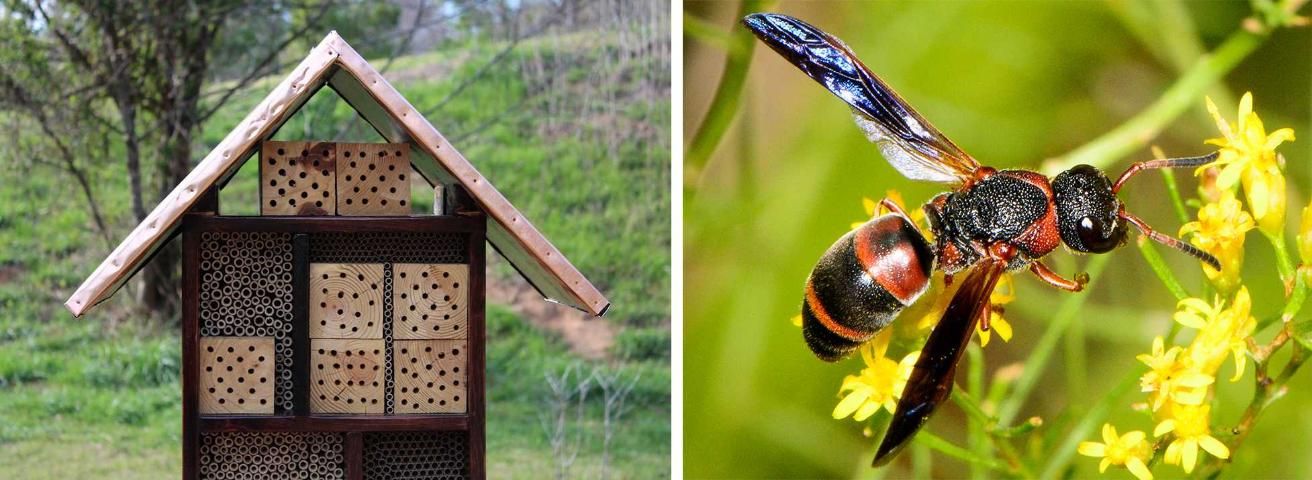
Credit: Jacquelyn Fitzgerald, NC State University (top); John Lampkin, bugguide.org (bottom)
Public Outreach and Engagement
Approximately 5 million people play over 60 million rounds of golf annually in Florida, while over 500 residential communities are centered around golf courses (Hodges and Stevens 2010; SRI 2015). Therefore, creating wildflower habitats in golf course out-of-play areas is an exceptional opportunity to engage with the public. One approach to this is creating signage adjacent to habitats, explaining what they are, why they are there, and where people can learn more (Figure 6). This is a business, outreach, and education opportunity, where superintendents can highlight the environmental stewardship they are participating in, while also educating golfers, community members, and youth about related scientific topics.
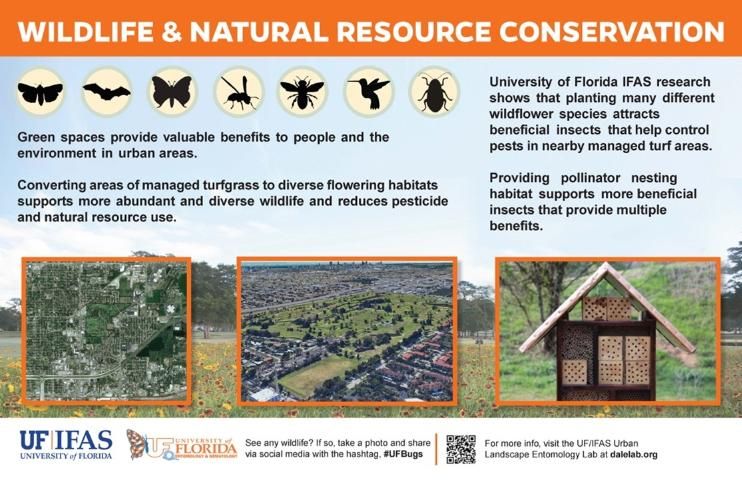
Credit: Adam Dale and Susan Rodriguez, UF/IFAS Entomology & Nematology Department
Keys to Success
- Select the proper site and wildflower species based on site characteristics (e.g., sun, soil, moisture).
- Plant wildflower seeds at the right time (mid–late fall).
- Ensure the correct seed density (80–120 PLS per ft.2) and seed-to-soil contact without disturbing the soil.
- Supplement rainfall as necessary during germination period to provide 1/4" water per day for 2–4 weeks.
- Weed manually every 2 weeks for first 2–3 months during germination period and occasionally thereafter.
- Allow seed to set, then remove dead plants and/or a portion of more aggressive wildflower species to provide space for less aggressive species (mid-December to early February).
Useful and Related Resources
- Video about the importance and effects of creating wildflower habitats on Florida golf courses (https://www.youtube.com/watch?v=vHmGBHJcqaU)
- Best management practices for the enhancement of environmental quality on Florida golf courses (https://ffl.ifas.ufl.edu/pdf/DEPGolfCourseBMP_Rev10_12_WEB.pdf)
- Creating large-scale butterfly habitats (https://edis.ifas.ufl.edu/ep420)
- Wildflowers susceptible to deer damage in north Florida (https://edis.ifas.ufl.edu/uw360)
- Establishment of lanceleaf tickseed in roadside right of ways (https://edis.ifas.ufl.edu/publication/ep367)
- Use of golf course ponds to support wetland birds (https://edis.ifas.ufl.edu/uw207)
- How to calculate pure live seed (PLS) rates (https://www.nrcs.usda.gov/Internet/FSE_PLANTMATERIALS/publications/lapmctn9045.pdf)
- GEO Foundation, Sustainable Golf Development Guidelines (https://sustainable.golf/files/Sustainable_Golf_Development_Guidelines.pdf)
- Audubon Cooperative Sanctuary Program (https://www.auduboninternational.org/acsp)
- Audubon International Monarchs in the Rough Program (https://monarchsintherough.org)
References
Abraham, C. M., D. W. Held, and C. Wheeler. 2010. "Seasonal and Diurnal Activity of Larra bicolor (Hymenoptera: Crabronidae) and Potential Ornamental Plants as Nectar Sources." Applied Turfgrass Science 7:0.
Biesmeijer, J., S. Roberts, M. Reemer, R. Ohlemuller, M. Edwards, T. Peeters, A. Schaffers, S. G. Potts, R. Kleukers, C. Thomas, J. Settele, and W. Kunin. 2006. "Parallel Declines in Pollinators and Insect-Pollinated Plants in Britain and the Netherlands." Science 313 (5785): 351–354. https://doi.org/10.1126/science.1127863
Blackmore, L. M., D. Goulson, A. Stewart, and M. Bezemer. 2014. "Evaluating the Effectiveness of Wildflower Seed Mixes for Boosting Floral Diversity and Bumblebee and Hoverfly Abundance in Urban Areas." Insect Conservation and Diversity 7:480–484.
Brower, L. P., E. H. Williams, K. S. Dunford, J. C. Dunford, A. L. Knight, J. Daniels, J. A. Cohen, T. Van Hook, E. Saarinen, M. J. Standridge, S. W. Epstein, M. P. Zalucki, and S. B. Malcolm. 2018. "A Long-Term Survey of Spring Monarch Butterflies in North-Central Florida." Journal of Natural History 52:2025–2046.
Colding, J., and C. Folke. 2009. "The Role of Golf Courses in Biodiversity Conservation and Ecosystem Management." Ecosystems 12:191–206.
Dale, A. G., R. L. Perry, G. C. Cope, and N. Benda. 2020. "Floral Abundance and Richness Drive Beneficial Arthropod Conservation and Biological Control on Golf Courses." Urban Ecosystems 23:55–66.
Frank, J. H., J. Parkman, and F. Bennett. 1995. "Larra bicolor (Hymenoptera: Specidae), a Biological Control Agent of Scapteriscus Mole Crickets (Orthoptera: Gryllotalpidae), Established in Northern Florida." The Florida Entomologist 78:619–623.
Goulson, D., E. Nicholls, C. Botias, and E. L. Rotheray. 2015. "Bee Declines Driven by Combined Stress from parasites, Pesticides, and Lack of Flowers." Science 347:1255957. https://doi.org/10.1126/science.1255957
Hamblin, A. L., E. Youngsteadt, M. M. Lopez-Uribe, and S. D. Frank. 2017. "Physiological Thermal Limits Predict Differential Responses of Bees to Urban Heat-Island Effects." Biology Letters 13:20170125. https://doi.org/10.1098/rsbl.2017.0125
Hodges, A. W., and T. J. Stevens. 2010. Economic Contributions of the Turfgrass Industry in Florida. University of Florida, Final Project Report to the Florida Turfgrass Association.
Kremen, C., N. M. Williams, M. A. Aizen, B. Gemmill-Herren, G. LeBuhn, R. Minckley, L. Packer, S. G. Potts, T. Roulston, I. Steffan-Dewenter, D. P. Vazquez, R. Winfree, L. Adams, E. E. Crone, S. S. Greenleaf, T. H. Keitt, A. M. Klein, J. Regetz, and T. H. Ricketts. 2007. "Pollination and Other Ecosystem Services Produced by Mobile Organisms: A Conceptual Framework for the Effects of Land-Use Change." Ecology Letters 10:299–314.
Lonsdorf, E. V., C. Nootenboom, B. Janke, and B. P. Horgan. 2021. "Assessing Urban Ecosystem Services Provided by Green Infrastructure: Golf Courses in the Minneapolis-St. Paul Metro Area." Landscape and Urban Planning 208:104022. https://doi.org/10.1016/j.landurbplan.2020.104022
Lyman, G. T., C. S. Throssell, M. E. Johnson, G. A. Stacey, and C. D. Brown. 2007. "Golf Course Profile Describes Turfgrass, Landscape, and Environmental Stewardship Features." Applied Turfgrass Science 4:1–25.
Mata, L., C. G. Threlfall, N. S. Williams, A. K. Hahs, M. Malipatil, N. E. Stork, and S. J. Livesley. 2017. "Conserving Herbivorous and Predatory Insects in Urban Green Spaces." Scientific Reports 7:40970.
Nestle, R., J. Daniels, and A. Dale. 2020. "Mixed-species Gardens Increase Monarch Oviposition Without Increasing Top-Down Predation." Insects 11 (9): 648.
Pelton, E. M., C. B. Schultz, S. J. Jepsen, S. H. Black, E. E. Crone. 2019. "Western Monarch Populations Plummets: Status, Probable Causes, and Recommended Conservation Actions." Frontiers in Ecology and Evolution. 7:258. https://doi.org/10.3389/fevo.2019.00258
Portman, S. L., J. H. Frank, R. McSorley, and N. C. Leppla. 2010. "Nectar-Seeking and Host-Seeking by Larra bicolor (Hymenoptera: Crabronidae), a Parasitoid of Scapteriscus Mole Crickets (Orthoptera: Gryllotalpidae)." Environmental Entomology 39:939–943.
SRI. 2015. The Florida Golf Economy: Full Report. Golf 20/20. https://cdn.cybergolf.com/images/1004/FL-Golf-Exec-Summ_SRI-FINAL.pdf
Winfree, R., I. Bartomeus, and D. Cariveau. 2011. "Native Pollinators in Anthropogenic Habitats." Annual Review of Ecology, Evolution, and Systematics 42:1–22.
Composition of two wildflower species mixtures evaluated by UF/IFAS for their performance and attractiveness to insect pollinators and predators.